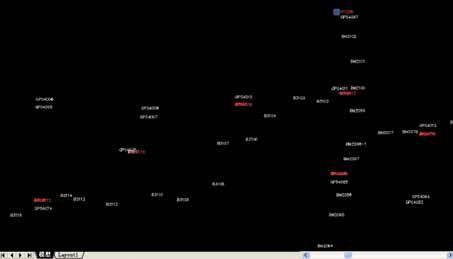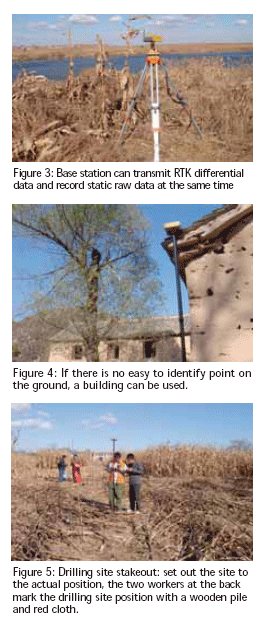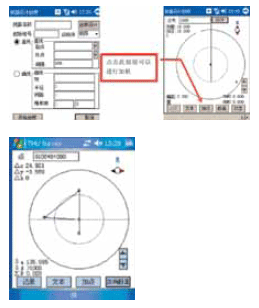| Surveying | |
Application of RTK system in railway construction
|
|||||||||||||||
|
Generally, the entire railway line is divided into several sections, and each section is fi nished separately. Firstly, we need to collect the existing information of one section, such as map and control points. Then, survey the topography of the working area, select position of control points, set the control point network, and produce the control points by GPS static survey. After control points are surveyed, we need to get the aero photograph of working area, draw 1:2000 relief map – to provide base data for railway designer. Besides the survey of control points, there are several steps that need the RTK system. • There is no coordinate information in aero photograph. In order to add coordinates to features after vectorization, photo-control points are needed to induct coordinates. • There is not enough information in relief maps that are vectorised from aero photograph, such as the direction of underground drain and feature details, for these supplementary survey in the fi eld is needed. • In order to survey the soil quality along the railway, drilling sites for geological sampling should be selected and surveyed. • The distribution and height of existing railway should be surveyed. • Pile stakeout should be done, which means to layout the designed railway coordinates to actual position in the field. • Transect which reflects the topographic changes along the railway should be surveyed. The entire flow of railway design can be depicted in a fl ow chart as: Figure 1: Work flow Control pointAccording to the survey principle of ‘Overall fi rst, parts second, control fi rst, detail second’, fi rst the survey work for control poin ts is done. After the designer has collected the existing information of one section, such as maps and control points, he will survey the topography of the working area, select position of control points, set the control point network, and produce the control points by GPS static survey. In this process, RTK system is used to collect static raw data for post-processing. As the RTK system records dual frequency raw data, the post-processing accuracy is higher than single frequency GPS receiver. The data format is ‘RINEX’ which is compatible with other survey systems and makes the work much more convenient and efficient. Figure 2: Control Network, a pair of GPS control points every 8 km and one bench mark every 2 km Photo control pointPhoto control point is a kind of control point that is used to calibrate the aero photograph. In railway design, aero photograph is used to generate 1:2000 relief map by vectorization. In order to add coordinates to features after vectorization, photo-control points are needed to induct coordinates. Generally, some feature points that are easy to identify are picked as photo control points, and then the points are surveyed in the fi eld. In actual fi eld work, since aero photograph with a scale of 1:10000 is used the features in the photograph are not exactly as the actual objects and sub-meter accuracy of photo control points is enough. Besides, the photo control points are distributed widely. So working with GPRS communication mode is advisable for long distance RTK survey. In this mode, the working distance is longer (up to 20~30km). Additionally, base station can record raw static data simultaneously while transmitting differential data. If there is no GPRS signal or bad GPRS signal in some regions, the working mode can be turned to ‘fast static’ (static survey every 15 minutes). Thus, the results can be obtained by post-processing. The two kinds of working modes ensure the fi eld work is smooth and at no risk. Supplement features and existing railway lineAs the required relief map with a scale of 1:2000 is more detailed than the aero photograph with the scale of 1:10000, the relief map converted from aero photograph will lack some of the detailed information about features. This information should be supplemented by surveying in the fi eld. Existing railway line information in working area is a kind of the supplementary information required. The points for supplement information and existing railway line can be surveyed with the function of ‘point survey’. In some places that are not covered in detail, the points can be obtained by ‘offset survey’. With the ‘Railway-design’ software, we can add attributes to the points. Adding a specifi c code to each kind of object, the points can be joined automatically into a graph according to the code after the fi le is imported into AUTOCAD program. Drilling site‘Drilling site’ is used for geological sampling to gain information about the geological conditions along the railway line. There are three steps which have to be followed at the drilling site. • Select the drilling site: according to the designed coordinates of railway, select points on the central line of the railway as the drilling sites. Designers select the sites in the fi eld, mark them with wooden piles and record the positions with handheld GPS receiver. These positions are used for navigation in the future. • Survey the drilling site: survey the coordinates of selected drilling sites. 3D coordinates are required and accuracy should be within 50cm. • Drilling site stakeout: according to the coordinates designed, fi nd the sites in the field. As the required accuracy of drilling site survey and stakeout is not high and the distribution of sites is wide, therefore the combination of GPRS communication mode and fast static survey mode is also ideal for these two steps. Pile stakeout and profile surveyPile: set a pile every N meters along the railway line, to control the direction of railway. Profile: vertical section that cuts along the center line. Pile mileage: the distance between the pile and the start point of line. Offset: the distance between projection point of RTK instruments and the center line of railway. Based on the coordinates of intersection, mileage of intersection, easement curve length, circular curve length and distance between piles, the mileage and coordinates of piles can be calculated. Then the piles can be set out in the fi eld with the stakeout function of railway-stakeout software. There are two ways to stakeout: • Coordinates stakeout: according to the coordinates of pile, the software will prompt the setover from current position to pile position. • Mileage stakeout: setover of ‘0’ means current position is on the center line of the railway. Go forward or back along the center line, when the mileage shows the same as the calculated mileage of the pile, current position is the right position. Survey profi le: along the center line of railway, survey the topographic points (such as ridge, wire, and canal). Using RTK system in this processThe design of railway is quite simple and fast. Railway-design software is quite advanced when designing a railway. For example to design a 40km long railway line, we only need the coordinates of intersection, distance between points of intersection, easement curve length, circular curve length and pile mileage. The main work is to arrange these elements in certain order and build a road fi le, and could be fi nished in 2 minutes. User-defi ned feature function. The function of user-defi ned features makes the inside and outside work much simpler. When surveying the profi le, if there is some topography point (such as the scarp), one needs to record the name and attributes of this point in a notebook, and then input this points details into the computer once back in the offi ce. But, with Railway-design software, the engineer can input attributes directly in the fi eld and save time. TransectTransect refl ects the topography situation on both sides of the railway. After confi rming the position of a pile, measure the topographic points along the transect direction to record the transect condition. There are many advantages of using RTK. Graphic is intuitionistic: when measuring transect, the departure distance from midline can be seen directly in the controller. It is more accurate than traditional visual method. Auto name: when measuring the profi le, the system names the fi rst point as d1, the second point as d2, etc. Add point: If the designed pile is on a bridge, transect of this pile cannot be measured. In this situation, ‘Add point’ function is used. Add pile before or behind this pile, and measure transect of added pile. To improve working effi ciency and reduce measurement mistakes caused by operation misplay, a lot of work can be done indoors: like making fi le for site calibration, making line fi le, making stakeout fi le, etc. RTK is applied in the railway industry quite early. It is widely used in the design and other aspects of railway construction. With the use of RTK GPS system, the working effi ciency of railway construction is signifi cantly improved. |
|||||||||||||||
|
|||||||||||||||
|


















 (1 votes, average: 2.00 out of 5)
(1 votes, average: 2.00 out of 5)




Leave your response!